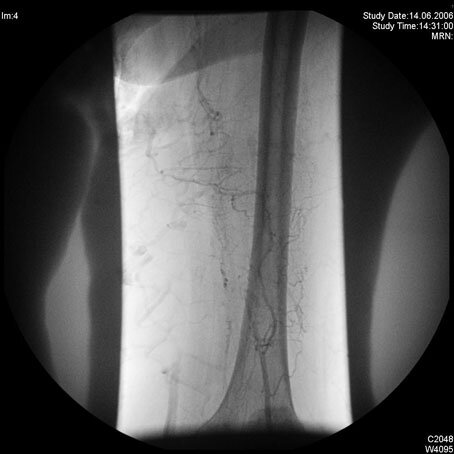Hämorrhoiden Spezialist, Hämorrhoiden Laser, Hämorrhoiden Arzt, Hämorrhoiden Stapler, Hämorrhoiden Behandlung, Hämorrhoiden Wien
What is thrombosis?
The term thrombosis refers to the formation of clots in the blood vessels (veins). Thrombosis most commonly develops in the deep veins of the legs (DVT - deep vein thrombosis) and statistically, 10% of the population will develop thrombosis at least once during their lifetime. Thrombophlebitis of the superficial veins must be distinguished from thrombosis. The causes of thrombosis can be congenital or acquired and the specific treatment depends on various factors. Immobilization is the most common cause of thrombosis.
What risks are associated with thrombosis?
If the blood clot (thrombus) becomes detached, it can travel to the lungs and cause a pulmonary embolism, which can even lead to death. The number of fatal pulmonary embolisms per year in Germany is estimated at over 30,000, making pulmonary embolism the third most common cause of death. Thrombosis can also lead to chronic venous insufficiency (known as “post-thrombotic syndrome” - PTS), which in turn manifests itself in advanced stages as wounds on the lower legs (open legs, ulcus cruris). 140,000 Austrians have an open leg, usually following a thrombosis. PTS leads to an average annual incapacity to work of 2 months.
How is a thrombosis recognized?
Depending on where it originates, DVT can manifest as pain and swelling of the lower leg or the entire leg. In the extreme form, sudden complete occlusion of all leg veins, a bluish discoloration of the leg also occurs (phlegmasia coerulea dolens) - this is an emergency situation that requires immediate surgical treatment.
The determination of D-dimers in the blood is a simple test to rule out a recent thrombosis. A normal D-dimer virtually rules out a phlebothrombotic event.
Color-coded duplex sonography is a non-stressful examination which, in experienced hands, is particularly suitable for detecting thromboses in the thigh and the hollow of the knee.
Phlebography is an X-ray examination of the veins using a contrast medium and is particularly helpful in the case of unclear findings in the lower leg area.
Angio-CT is a computer tomography with contrast medium and is valuable for findings in the abdominal and thoracic cavity.

How can thrombosis be prevented?
By activating the muscle pump, the blood is forced to flow faster, thus minimizing the risk of clot formation. Mobilization (movement) is therefore an important preventive measure.
If movement is not possible, compression stockings can be worn and medication to prevent blood clotting (e.g. heparin preparations) can be administered. After a thrombosis, it is often necessary to take such medication for a longer period of time.
How is acute thrombosis treated?
Depending on the severity, the clinical picture of the disease and the risk factors, appropriate treatment is initiated. This ranges from compression treatment with anticoagulant medication to thrombolysis (dissolving the blood clots with infusions) and surgical measures (thrombectomy: removal of the blood clots from the affected veins using a balloon catheter). The faster treatment is initiated, the more effective it will be.
Author: Dr. Andreas Franczak, specialist in surgery, vascular surgery and visceral surgery